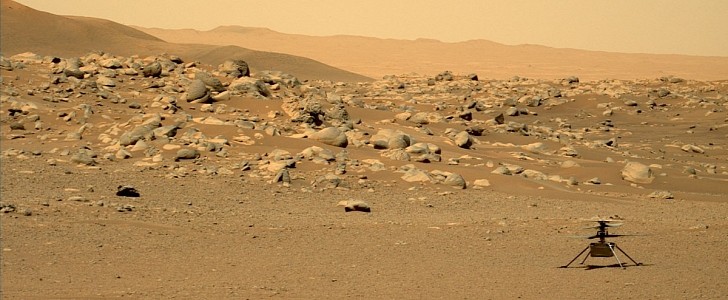NASA's Ingenuity helicopter has been on the Red Planet for more than a year. Since it landed with the Perseverance rover, the little rotorcraft proved that it could not only fly in the thin Martian atmosphere but also act as an aerial scout for its robotic partner. But even the mighty helicopter can have a hard time flying on Mars when the dust and cold intensify.
It's been a dusty year full of surprises for scientists. Ingenuity became the first aircraft to fly on another world, proving each time that it can do much more than it was originally meant to. Now, after 28 flights, the helicopter is facing some challenges.
The weather on Mars is turning cold since winter is right around the corner. In the Jezero Crater, where Ingenuity and Perseverance are, scientists have noticed that the amount of dust in the air has increased, the temperatures have dropped, and the days have gotten shorter.
All of these factors combined took a toll on Ingenuity's energy supply to the point where it is unable to keep its instruments warm throughout the cold Martian nights. To save battery power, the Ingenuity team has commanded the helicopter to shut down at nighttime. But this cycle, along with the alternating temperatures, has led to a failed instrument.
During a preflight check of sensors and actuators, the team noticed that Ingenuity's inclinometer stopped functioning. The inclinometer is part of a complex navigation suite that also includes a navigation camera and a laser rangefinder, which work together to help Ingenuity determine its position, velocity, and orientation when flying on the Red Planet.
"A nonworking navigation sensor sounds like a big deal — and it is — but it's not necessarily an end to our flying at Mars," wrote Håvard Grip, Ingenuity's chief pilot, in a blog post.
Fortunately, the scientists were prepared for this scenario and have the necessary software patch. Once they apply the software patch and finalize uplinking, the team will check if everything functions accordingly. If all goes well, Ingenuity will gear up for its next flight and strive to do its best to help the Perseverance rover investigate the ancient river delta on Mars.
The weather on Mars is turning cold since winter is right around the corner. In the Jezero Crater, where Ingenuity and Perseverance are, scientists have noticed that the amount of dust in the air has increased, the temperatures have dropped, and the days have gotten shorter.
All of these factors combined took a toll on Ingenuity's energy supply to the point where it is unable to keep its instruments warm throughout the cold Martian nights. To save battery power, the Ingenuity team has commanded the helicopter to shut down at nighttime. But this cycle, along with the alternating temperatures, has led to a failed instrument.
During a preflight check of sensors and actuators, the team noticed that Ingenuity's inclinometer stopped functioning. The inclinometer is part of a complex navigation suite that also includes a navigation camera and a laser rangefinder, which work together to help Ingenuity determine its position, velocity, and orientation when flying on the Red Planet.
"A nonworking navigation sensor sounds like a big deal — and it is — but it's not necessarily an end to our flying at Mars," wrote Håvard Grip, Ingenuity's chief pilot, in a blog post.
Fortunately, the scientists were prepared for this scenario and have the necessary software patch. Once they apply the software patch and finalize uplinking, the team will check if everything functions accordingly. If all goes well, Ingenuity will gear up for its next flight and strive to do its best to help the Perseverance rover investigate the ancient river delta on Mars.







